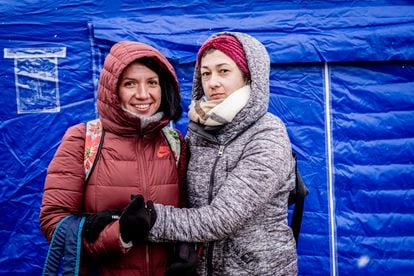Ukrainian exodus could be Europe’s biggest refugee crisis since World War II
Thousands are crossing into Romania every day through the border post in Siret, where emergency workers are greeting exhausted people with hot food and water
/cloudfront-eu-central-1.images.arcpublishing.com/prisa/G3FCEGRGCFERZFT5ZNTJKEBF34.jpg)
The scope of the humanitarian crisis in Ukraine, a country of 44.3 million people, can be measured by how quickly the figures change. When the Russian offensive began seven days ago, there was talk of tens of thousands of potential refugees. Just a few days later it was hundreds of thousands. On Wednesday, the United Nations refugee agency UNHCR said one million people had already escaped the war-torn country, and estimated that as many as four million could do so in the coming weeks and months.
More than half have crossed into Poland, which shares a 500-kilometer border with Ukraine. The rest have gone to Hungary, Moldova, Slovakia, Romania and Russia. “The profile keeps changing. At first, they were going to the house of a friend or relative. Now they have no plan at all,” said Sorin Ionita, director of the think tank Expert Forum, speaking from Isaccea, a small Romanian port city on the Danube river.
“You hear shots constantly, everywhere, which means their safety is fragile; we’re also getting hundreds of desperate calls [from people who] are unable to reach the border,” said Gabriela Leu, a spokeswoman for UNHCR Romania.
It is already Europe’s biggest refugee crisis since the Balkan wars of the 1990s, and if the pace keeps up, it could soon become the worst since World War II. The UN has launched an urgent appeal for $1.7 billion (€1.53 billion) in humanitarian funds to help the refugees, who are mostly women and children. And the European Commission on Wednesday greenlighted a special mechanism granting international protection to all Ukrainians fleeing their country; the initiative is expected to get final legislative approval on Thursday.

On the Ukrainian side of the main border crossing into the Romanian town of Siret, there was a line of cars stretching more than 12 miles (20 km) at around noon on Wednesday. The journey from Kyiv, which normally takes eight hours, can take as long as two days right now. Some people had chosen to cover the last few miles on foot, walking on the curb alongside the traffic snarl despite the snow and the cold.
Iryna Draganova and Elizaveta, two middle-aged pianists from the eastern Ukrainian city of Mariupol, could consider themselves either lucky to be alive or unlucky to be in their current predicament. Speaking on the Romanian side of the border, Draganova said that a few hours before the start of the invasion they were at Kyiv airport, getting ready to fly to the German city of Dortmund to visit some friends. But the airspace was closed and they were forced to choose between staying with friends in Kyiv (currently under attack), returning to Mariupol (now nearly surrounded by Russian troops) or leaving the country entirely. “We stayed in Kyiv at first, but a lot of bombs made us change our minds,” said Draganova, resorting to humor to deal with the situation. “We will return as soon as possible, when Ukraine is again an independent and sovereign country.”

Jacob Bencharsi, 38, has been in Romania for two days. He was evacuated from the city of Khmelnytskyi by his Baptist church, and as the father of three children, he is one of the few men of fighting age who was allowed to leave the country under the martial law declared last week by Ukrainian President Volodymyr Zelenskiy. “The situation has deteriorated very quickly,” he said. “Along the way, we kept hearing the air raid sirens and realized that getting out was a good decision.”
The magnitude of the refugee crisis can be appreciated in the Romanian town of Siret, where in just 24 hours 16 emergency tents have been erected near the border. There are stands offering food, tea, water bottles and free diapers for the new arrivals. “We are mostly offering hot meals, soups and chicken. We know that as many as 10,000 people are coming in every day, and we calculate the amounts based on that,” said Morgan Rains of World Central Kitchen, a non-profit group created by the Spanish-American celebrity chef José Andrés.
“We still haven’t reached the same number of people who fled the Balkans war, but it could be greater than that if this war drags out,” said Ionita. The pace of the exodus is greater than in 2015, when over a million refugees – mostly from Syria, Afghanistan and Iraq – fled to Europe. The closest precedent is 1999, when nearly 800,000 Kosovo Albanians crossed into Albania and North Macedonia when NATO started to bomb Serbia.
“If the war in Ukraine continues, the demographic consequences could be colossal compared with those caused by the dismemberment of the former Yugoslavia,” said Dumitru Sandu, an expert in migrations at Bucarest University. As for Romania, it had not dealt with such a refugee crisis since the days of World War II, when tens of thousands of Polish nationals, including government members, were taken in right after the Soviet Union invaded Poland.
/cloudfront-eu-central-1.images.arcpublishing.com/prisa/RK3T4LJCNZVGDIOWRBJEHT7SU4.jpg)
/cloudfront-eu-central-1.images.arcpublishing.com/prisa/GRULPASZX5V4VG4FJYUBP7MYJI.jpg)










































